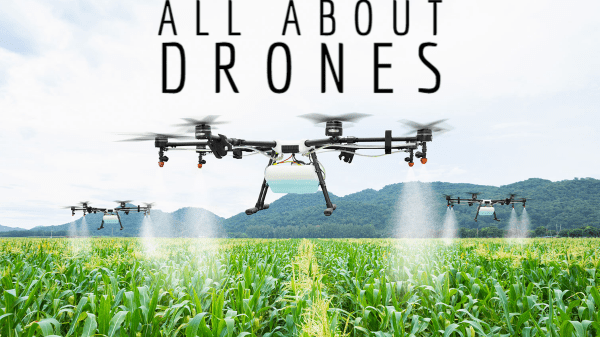Swarms of drones will be commonplace in orchards and fields one day.
So says Christian Nansen, associate professor in the Department of Entomology and Nematology at the University of California, Davis. He says they’ll handle a wide range of tasks from augmenting pollination and gauging moisture to the detection of harmful pests and ways to eliminate them.
Helping pollination
Dropcopter, Inc., headquartered in Syracuse, NY, uses custom drones equipped with software and patented pollinator delivery systems.
Matt Kopall, CEO and co-founder of Dropcopter, says delivering supplemental pollinators by drone allows for more targeted applications. The company’s pollinator device is attached to a drone that flies about 10 to 12 feet over an orchard, and the drone’s downdraft pushes material into the trees.
Even though the pollinated material isn’t effective when it’s too cold and drones aren’t suited to high winds, Kopall says his customers are seeing up to 50 percent higher yields.
Dropcopter operates in New York, California, Washington, Brazil, and Israel. An estimated average cost for its supplemental pollination is $300 per acre, which includes two applications.
Saving strawberries
Parabug, LLC, an ag tech company based in Salinas, CA, uses drones to combatting pest infestations. Acting as combat carriers, drones drop beneficial insects into fields to attack mites, which are harmful to many plants, including strawberries.
The company’s founder, Chandler Bennett, developed a patent-pending device that involves a tube filled with beneficial insects and a rotating drum that deposits them into the field.
The mechanism was prototyped while Bennett was in college and made commercially available in 2016. It uses a persimilis, a beneficial insect about the size of a pinhead, to go after strawberry mites.
“It essentially works like a salt-shaker,” says Jaclyn Bennett, general manager of Parabug, who says interest in the company’s services is increasing, especially from growers who are keen to reduce labor costs.
“The labor to put out the beneficial insect by hand is very expensive, and labor is harder and harder to come by,” she says.
The company operates 11 drones in such places as California, Florida, and Australia.
One of the growers using Parabug’s services is Tim Driscoll, who operates West Coast Berry Farms in Santa Maria, CA.
Driscoll started using Parabug’s services about a year ago, looking for spider mites, which can devastate strawberry plants. Delivering a biologic by drone takes about a day to cover 100 acres, compared to the two to three days and 25 workers to deliver it by hand.
Drones not only save time and reduce labor costs but allow the company to work on days when conditions aren’t optimal, like when excessive rain has made it difficult for workers to get into a field to deliver the insects.
Whether a grower is delivering persimilis by hand or drone, Driscoll notes that it takes time to start working because it’s not the insects that are dispatched, but their offspring, that do the work.
“We like to get the insects in as soon as possible because it takes about a week for them to lay eggs and become effective,” he says.
Another grower that has used drones for delivering predator mites is Bobalu Berries BB #:354734 in Salinas, CA. Cindy Jewell of Jewell Marketing, who represents Bobalu, LLC in Oxnard, CA, says the company “found it was very efficient, both with timing to get the project done, and with reduced labor.”
For growers considering the use of drones, Jewell recommends taking it slow.
“The advice I would give is for farmers to consider a pilot program or test field to assess how drone technology and delivery could reduce labor costs and increase efficiencies,” she says.
This is an excerpt from the Applied Technology feature from the May/June 2021 issue of Produce Blueprints Magazine. Click here to read the whole issue.



